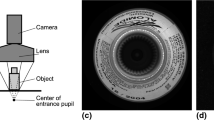Abstract
In order to calibrate cameras in an accurate manner, lens distortion models have to be included in the calibration procedure. Usually, the lens distortion models used in camera calibration depend on radial functions of image pixel coordinates. Such models are well-known, simple and can be estimated using just image information. However, these models do not take into account an important physical constraint of lens distortion phenomena, namely: the amount of lens distortion induced in an image point depends on the scene point depth with respect to the camera projection plane. In this paper we propose a new accurate depth dependent lens distortion model. To validate this approach, we apply the new lens distortion model to camera calibration in planar view scenarios (that is 3D scenarios where the objects of interest lie on a plane). We present promising experimental results on planar pattern images and on sport event scenarios. Nevertheless, although we emphasize the feasibility of the method for planar view scenarios, the proposed model is valid in general and can be used in any scenario where the point depth can be estimated.
Similar content being viewed by others
References
Alemán-Flores, M., Alvarez, L., Henríquez, P., Mazorra, L.: Morphological thick line center detection. In: Proceedings ICIAR’2010. LNCS, vol. 6111, pp. 71–80. Springer, Berlin (2010)
Alvarez, L., Esclarín, J., Trujillo, A.: A model based edge location with subpixel precision. In: Proceedings IWCVIA 03: International WorkShop on Computer Vision and Image Analysis (Las Palmas de Gran Canaria, Spain), pp. 29–32 (2003)
Alvarez, L., Gomez, L., Sendra, R.: An algebraic approach to lens distortion by line rectification. J. Math. Imaging Vis. 35(1), 36–50 (2009)
Brakhage, P., Notni, G., Kowarschik, R.: Image aberrations in optical three-dimensional measurement systems with fringe projection. Appl. Opt. 3217–3223 (2004)
Bräuer-Burchardt, C., Heinze, M., Munkelt, C., Kühmstedt, P., Notni, G.: Distance dependent lens distortion variation in 3D measuring systems using fringe projection. In: BMVC 2006, pp. 327–336 (2006)
Brown, D.C.: Close-range camera calibration. Photogr. Eng. 37, 855–866 (1971)
Burner, A.W.: Zoom lens calibration for wind tunnel measurements. In: Proceedings of SPIE, Videometrics IV, vol. 2598, pp. 19–33 (1995)
Claus, D., Fitzgibbon, A.W.: A rational function lens distortion model for general cameras. In: Proceedings of the 2005 IEEE Computer Society Conference on Computer Vision and Pattern Recognition Conference CVPR’05, pp. 1063–6919 (2005)
Devernay, F., Faugeras, O.: Straight lines have to be straight. Mach. Vis. Appl. 13(1), 14–24 (2001)
Dold, J.: Ein hybrides photogrammetrisches Industriemesssystemhöchster Genauigkeit und seiner Überprüfung. PhD thesis, Universität der Bundeswehr München (1997)
Faugeras, O.: Three-Dimensional Computer Vision. MIT Press, Cambridge (1993)
Faugeras, O., Luong, Q.-T., Papadopoulo, T.: The Geometry of Multiple Images. MIT Press, Cambridge (2001)
Fraser, C.S., Shortis, M.R.: Variation of distortion within the photographic field. Photogramm. Eng. Remote Sensing. 58(6), 851–855 (1992)
Fryer, J.G., Mason, S.O.: Rapid lens calibration of a video camera. Photogramm. Eng. Remote Sensing 55(4), 437–444 (1989)
Green, P., Sun, W., Matusik, W., Durand, F.: Multi-Aperture Photography. ACM Trans. Graph. 26(3), 68 (2007)
Hanning, T.: High precision camera calibration with a depth dependent distortion mapping. In: Proceedings International Conference on Visualization, Imaging and Image Processing Conference (VIIP), Palma de Mallorca, Spain, pp. 304–309 (2008)
Hartley, R., Kang, S.B.: Parameter-free radial distortion correction with center of distortion estimation. IEEE Trans. Pattern Anal. Mach. Intell. 29(8), 1309–1321 (2007)
Hartley, R., Zisserman, A.: Multiple View Geometry in Computer Vision. Cambridge University Press, Cambridge (2000)
Hasinoff, S.W., Kutulakos, K.N.: Confocal stereo. Int. J. Comput. Vis. 81(1), 82–104 (2009)
Light, D.L.: The new camera calibration system at the U.S. geological survey. Photogramm. Eng. Remote Sensing 58(2), 185–188 (1992)
Magill, A.A.: Variation in distortion with magnification. J. Res. Nat. Bur. Stand. 54(3), 135–142 (1955)
Ricolfe-Viala, C., Sanchez-Salmeron, A.J.: Robust metric calibration of non-linear camera lens distortion. Pattern Recogn. 43(4), 1688–1699 (2010)
Rosten, E., Loveland, R.: Camera distortion self-calibration using the plumb-line constraint and minimal Hough entropy. Mach. Vis. Appl. 1–9 (2009)
Song, G.-Y., Lee, J.-W.: Correction of radial distortion based on line-fitting. Int. J. Control, Autom. Syst. 8(3), 615–621 (2010)
Tardif, J.P., Sturm, P., Roy, S.: Self-calibration of a general radially symmetric distortion model. In: Proceedings The 9th European Conference on Computer Vision, Graz, Austria. LNCS, vol. 3954, pp. 186–199. Springer, Berlin (2006)
Tsai, R.Y.: A versatile camera calibration technique for high-accuracy 3d machine vision metrology using off-the-shelf tv cameras and lenses. IEEE J. Robot. Autom. 3(4), 323–344 (1987)
Wang, J., Shi, F., Zhang, J., Liu, Y.: A new calibration model of camera lens distortion. Pattern Recogn. 41(2), 607–615 (2008)
Wang, J., Gu, W., Zhu, J., Zhang, J.: Calibration of lens distortion based on plane constraints. In: IEEE International Conference on Digital Image Processing, Los Alamitos, CA, USA, pp. 355–358 (2009)
Wang, A., Qiu, T., Shao, L.: A simple method of radial distortion correction with centre of distortion estimation. J. Math. Imaging Vis. 35(3), 165–172 (2009)
Wiley, A.G., Wong, K.W.: Geometric calibration of zoom lenses for computer vision metrology. Photogramm. Eng. Remote Sensing 61(1), 69–74 (1995)
Zhang, Z.: A flexible new technique for camera calibration. IEEE Trans. Pattern Anal. Mach. Intell. 22(11), 1330–1334 (2000)
Author information
Authors and Affiliations
Corresponding author
Rights and permissions
About this article
Cite this article
Alvarez, L., Gómez, L. & Sendra, J.R. Accurate Depth Dependent Lens Distortion Models: An Application to Planar View Scenarios. J Math Imaging Vis 39, 75–85 (2011). https://doi.org/10.1007/s10851-010-0226-2
Published:
Issue Date:
DOI: https://doi.org/10.1007/s10851-010-0226-2




